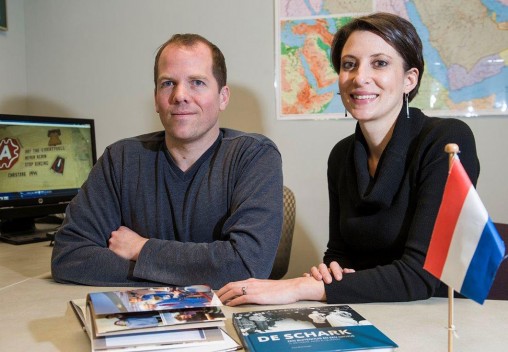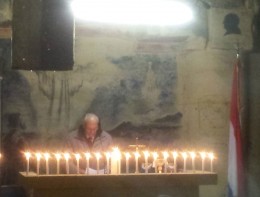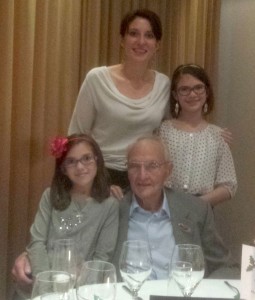
Vaughn Shannon, associate professor of political science, and Mandy Shannon, coordinator of library instruction and assessment, traveled with Mandy’s grandfather Robert Wisler to witness an annual Dutch Christmas Eve tribute to World War II liberators.
Seventy years ago during World War II, he helped pin an American flag to the walls of a limestone cave while the bloody Battle of the Bulge raged nearby. The flag is still there, a lasting testament to the gratitude of the Dutch residents liberated from the Nazis by American soldiers.
Robert Wisler, of Bryan, Ohio, was among the soldiers who arrived just after the liberation. His U.S. Army unit camped by the cave near Maastricht in 1944 when he was a 19-year-old supply sergeant.
Last December, the 90-year-old Wisler took his family back to the cave for its annual celebration of Christmas Eve Mass.
Among the family members were his granddaughter, Mandy Shannon, coordinator of library instruction and assessment at Wright State University, and her husband, Vaughn Shannon, associate professor of political science.
“It was very touching,” said Mandy Shannon. “For me personally, it was seeing my grandpa through the eyes of people who saw him as their liberator.”

Robert Wisler was among the soldiers who participated in a Christmas Eve Mass in a cave near Maastricht in 1944. He returned there in December.
Shannon said she grew up realizing that her grandfather — who made a career as a wood and metal pattern maker with his own shop — had been in the war, but knew nothing else about it other than he had signed his name on the wall of some cave. She learned only a few months ago that he had been at Omaha Beach six days after D-Day (the water still ran red with blood) and had arrived at a German concentration camp just days after it had been liberated.
Maastricht was quickly taken by the Germans during the Battle of Maastricht in May 1940, but was the first Dutch city to be liberated by allied forces, on Sept. 14, 1944. The majority of Maastricht Jews died in Nazi concentration camps.
The cave was formed as part of a limestone quarry and is near a monastery of the Brothers of the Immaculate Conception of Maastricht, who used it as a shelter and as a place to create artworks.
On Christmas Eve 1944, with fighting going on nearby, the monks decided to hold Mass in the cave instead of church. That first cave Mass included Shannon’s grandfather’s unit, but there were also soldiers who were bused in from the front lines of the Battle of the Bulge. A total of 250 people huddled together for the underground ceremony.
For the soldiers, it was a rare moment of respite from the terror of battle. Guns and bullets were put down for prayer and then hot chocolate and doughnuts.
“A lot of the guys who were there that night not only didn’t make it to today, they didn’t make it through the war,” Shannon said. “They were killed. There are very, very few people who were in that cave who are still living.”
An artist in the Army unit painted a mural on a cave wall that connected Maastricht to the Statue of Liberty. Wisler and other soldiers charcoaled their names on another wall next to a note from the monks praying for an end to the fighting and expressing gratitude for being liberated from a terrible occupation.
During the Mass last December, an emotional Wisler spoke and told the gathering of 250 people how honored he felt.
“I think he was remembering what it was like to be there as a 19-year-old and then to be there in this totally different context,” said Shannon. “I don’t think there was a dry eye in the cave.”

Mandy Shannon with her grandfather Robert Wisler and daughters, Sophia and Cate, at the annual celebration of Christmas Eve Mass last December.
“The Star Spangled Banner” was sung, and there was a presentation of the colors. Then the names of U.S. and Dutch service members who had died in the past year were read and a candle lighted for each one.
Vaughn Shannon said the annual Christmas Eve Masses show that there can be lasting effects in international relations between peoples.
“It really does seep down into the culture,” he said.
The Dutch have established a foundation to stage the Masses and are in the process of turning the cave into a national historic site.
“This is definitely something that is kept alive,” said Mandy Shannon. “There is something very, very profound about the history and the repetition of this.”

 Wright State celebrates Student Success Champions
Wright State celebrates Student Success Champions  Wright State gold team captures 2024 Horizon League team title, Flynn individual champion
Wright State gold team captures 2024 Horizon League team title, Flynn individual champion  118 medical students to graduate from Wright State’s Boonshoft School of Medicine April 28
118 medical students to graduate from Wright State’s Boonshoft School of Medicine April 28  Wright State University continues to demonstrate its financial strength with another credit rating upgrade from Moody’s
Wright State University continues to demonstrate its financial strength with another credit rating upgrade from Moody’s  Thousands celebrate the end of Spring Semester with food, fun and friendship
Thousands celebrate the end of Spring Semester with food, fun and friendship 